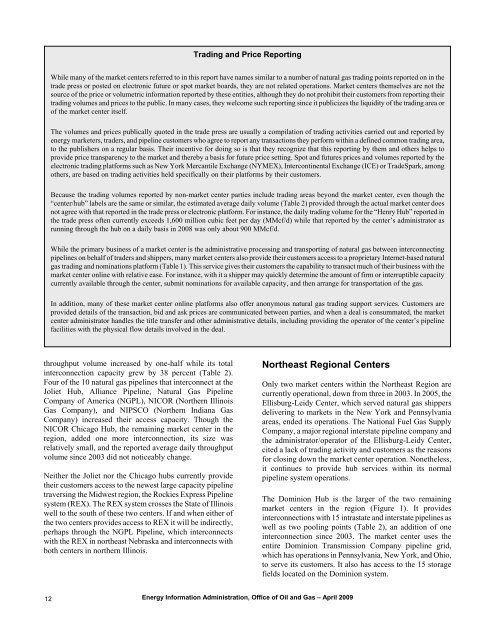Natural Gas Market Centers: A 2008 Update - EIA
Natural Gas Market Centers: A 2008 Update - EIA
Natural Gas Market Centers: A 2008 Update - EIA
Create successful ePaper yourself
Turn your PDF publications into a flip-book with our unique Google optimized e-Paper software.
throughput volume increased by one-half while its total<br />
interconnection capacity grew by 38 percent (Table 2).<br />
Four of the 10 natural gas pipelines that interconnect at the<br />
Joliet Hub, Alliance Pipeline, <strong>Natural</strong> <strong>Gas</strong> Pipeline<br />
Company of America (NGPL), NICOR (Northern Illinois<br />
<strong>Gas</strong> Company), and NIPSCO (Northern Indiana <strong>Gas</strong><br />
Company) increased their access capacity. Though the<br />
NICOR Chicago Hub, the remaining market center in the<br />
region, added one more interconnection, its size was<br />
relatively small, and the reported average daily throughput<br />
volume since 2003 did not noticeably change.<br />
Neither the Joliet nor the Chicago hubs currently provide<br />
their customers access to the newest large capacity pipeline<br />
traversing the Midwest region, the Rockies Express Pipeline<br />
system (REX). The REX system crosses the State of Illinois<br />
well to the south of these two centers. If and when either of<br />
the two centers provides access to REX it will be indirectly,<br />
perhaps through the NGPL Pipeline, which interconnects<br />
with the REX in northeast Nebraska and interconnects with<br />
both centers in northern Illinois.<br />
12<br />
Trading and Price Reporting<br />
While many of the market centers referred to in this report have names similar to a number of natural gas trading points reported on in the<br />
trade press or posted on electronic future or spot market boards, they are not related operations. <strong>Market</strong> centers themselves are not the<br />
source of the price or volumetric information reported by these entities, although they do not prohibit their customers from reporting their<br />
trading volumes and prices to the public. In many cases, they welcome such reporting since it publicizes the liquidity of the trading area or<br />
of the market center itself.<br />
The volumes and prices publically quoted in the trade press are usually a compilation of trading activities carried out and reported by<br />
energy marketers, traders, and pipeline customers who agree to report any transactions they perform within a defined common trading area,<br />
to the publishers on a regular basis. Their incentive for doing so is that they recognize that this reporting by them and others helps to<br />
provide price transparency to the market and thereby a basis for future price setting. Spot and futures prices and volumes reported by the<br />
electronic trading platforms such as New York Mercantile Exchange (NYMEX), Intercontinental Exchange (ICE) or TradeSpark, among<br />
others, are based on trading activities held specifically on their platforms by their customers.<br />
Because the trading volumes reported by non-market center parties include trading areas beyond the market center, even though the<br />
“center/hub” labels are the same or similar, the estimated average daily volume (Table 2) provided through the actual market center does<br />
not agree with that reported in the trade press or electronic platform. For instance, the daily trading volume for the “Henry Hub” reported in<br />
the trade press often currently exceeds 1,600 million cubic feet per day (MMcf/d) while that reported by the center’s administrator as<br />
running through the hub on a daily basis in <strong>2008</strong> was only about 900 MMcf/d.<br />
While the primary business of a market center is the administrative processing and transporting of natural gas between interconnecting<br />
pipelines on behalf of traders and shippers, many market centers also provide their customers access to a proprietary Internet-based natural<br />
gas trading and nominations platform (Table 1). This service gives their customers the capability to transact much of their business with the<br />
market center online with relative ease. For instance, with it a shipper may quickly determine the amount of firm or interruptible capacity<br />
currently available through the center, submit nominations for available capacity, and then arrange for transportation of the gas.<br />
In addition, many of these market center online platforms also offer anonymous natural gas trading support services. Customers are<br />
provided details of the transaction, bid and ask prices are communicated between parties, and when a deal is consummated, the market<br />
center administrator handles the title transfer and other administrative details, including providing the operator of the center’s pipeline<br />
facilities with the physical flow details involved in the deal.<br />
Northeast Regional <strong>Centers</strong><br />
Energy Information Administration, Office of Oil and <strong>Gas</strong> – April 2009<br />
Only two market centers within the Northeast Region are<br />
currently operational, down from three in 2003. In 2005, the<br />
Ellisburg-Leidy Center, which served natural gas shippers<br />
delivering to markets in the New York and Pennsylvania<br />
areas, ended its operations. The National Fuel <strong>Gas</strong> Supply<br />
Company, a major regional interstate pipeline company and<br />
the administrator/operator of the Ellisburg-Leidy Center,<br />
cited a lack of trading activity and customers as the reasons<br />
for closing down the market center operation. Nonetheless,<br />
it continues to provide hub services within its normal<br />
pipeline system operations.<br />
The Dominion Hub is the larger of the two remaining<br />
market centers in the region (Figure 1). It provides<br />
interconnections with 15 intrastate and interstate pipelines as<br />
well as two pooling points (Table 2), an addition of one<br />
interconnection since 2003. The market center uses the<br />
entire Dominion Transmission Company pipeline grid,<br />
which has operations in Pennsylvania, New York, and Ohio,<br />
to serve its customers. It also has access to the 15 storage<br />
fields located on the Dominion system.

















